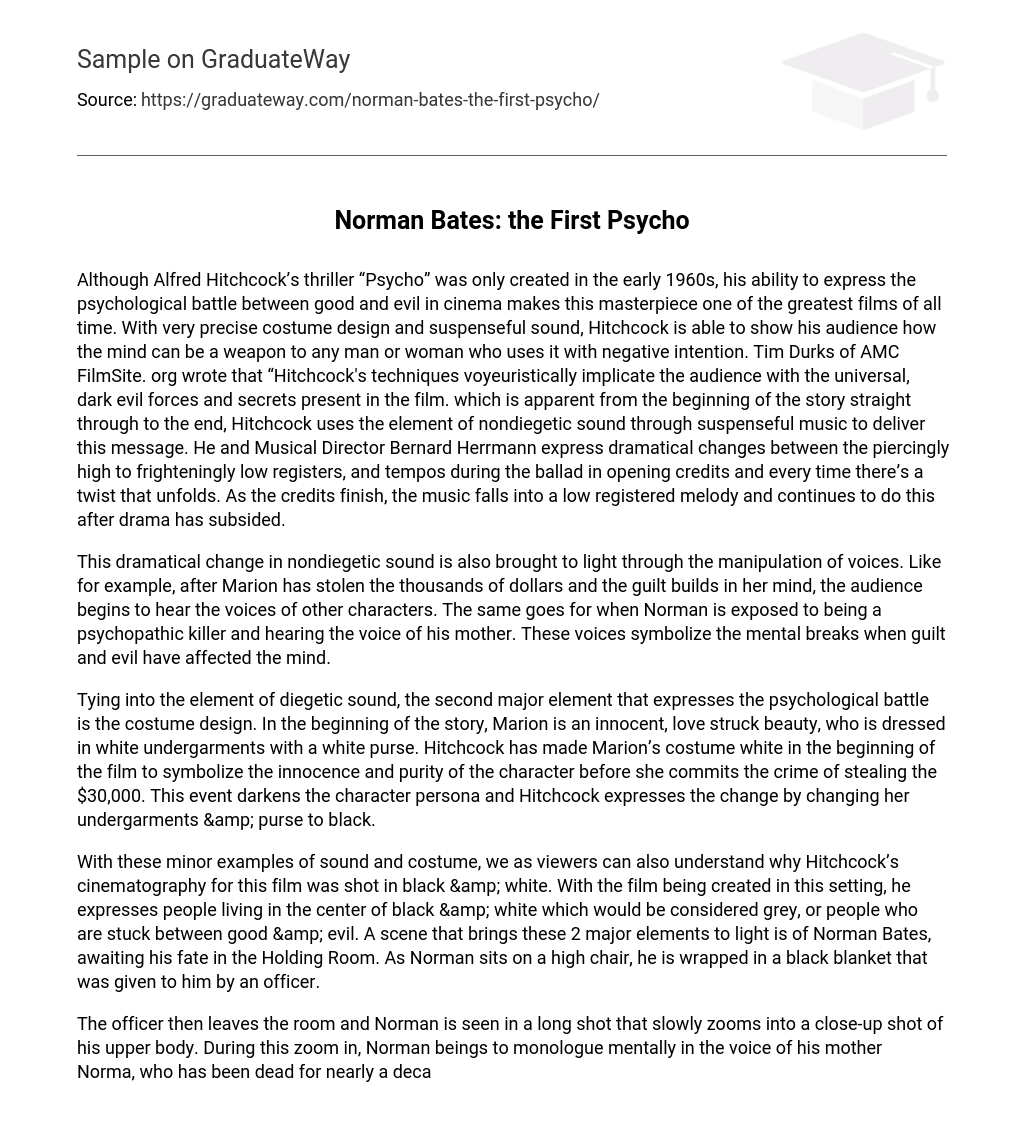Despite being created in the early 1960s, Alfred Hitchcock’s thriller “Psycho” is considered one of the greatest films of all time due to its portrayal of the psychological battle between good and evil in cinema. Hitchcock achieves this through meticulous costume design and suspenseful sound, showcasing how the mind can be wielded as a weapon for malicious purposes. According to Tim Durks of AMC FilmSite.org, Hitchcock’s techniques immerse the audience in the film’s universal themes of dark evil forces and secrets from start to finish.
Hitchcock effectively utilizes nondiegetic sound, specifically suspenseful music, to convey this message. Working alongside Musical Director Bernard Herrmann, he creates dramatic changes in pitch and tempo during the film’s opening credits and whenever a twist is unveiled. The music starts with a hauntingly high register and gradually descends into a lower melody as the credits conclude, maintaining this pattern even after the climax of the story.
The manipulation of voices highlights the dramatic change in nondiegetic sound. For instance, when Marion steals the money and guilt consumes her, the audience starts hearing the voices of other characters. Similarly, when Norman is revealed as a psychopathic killer, he hears his mother’s voice. These voices symbolize the mental breakdown caused by guilt and evil infiltrating the mind.
Tying into the element of diegetic sound, the second major element that expresses the psychological battle is the costume design. At the start of the story, Marion appears as a pure and innocent beauty, adorned in white undergarments and carrying a white purse. Hitchcock deliberately chooses white to symbolize her innocence and purity before she succumbs to the temptation of stealing $30,000. This pivotal event significantly alters her character, as evidenced by her transition from white undergarments & purse to black.
The use of sound and costume in the film highlights the reason why Hitchcock chose to film it in black & white. By depicting people living in a world that is neither completely black nor completely white, Hitchcock conveys the idea of being caught between good and evil. One scene that exemplifies these contrasting elements is when Norman Bates sits in the Holding Room, draped in a black blanket provided by an officer.
The officer exits the room while Norman is shown in a long shot. The camera gradually zooms in on his upper body, and during this zoom, he begins to mentally monologue as his deceased mother, Norma. Despite her absence for many years, Norman’s facial expressions shift from sadness to satisfaction, yet with an underlying sinister intention. Eventually, the audience is presented with an extreme close-up of Norman’s hand, where a fly lands.
As Norman gazes upon the pest, his mother’s voice reminds him that she “wouldn’t even harm a fly”, causing him to spare the fly. This line is accompanied by a close-up shot of Norman, who is smiling in contrast to previous scenes. As the monologue ends, Norman’s smile takes on a sinister quality, depicted through a still frame showing his face transformed into a skeleton. This scene holds significant importance in analyzing the formal elements of Cinematography and Sound, as it allows the audience to discern the contrasting elements present.
In this scene, various elements of cinematography and sound design are used to highlight the transformation of Norman into an evil character. For instance, shots such as Norman’s long shot in the black blanket, the close-up of the black fly, and the still shot of the skeleton all contribute to this effect. Additionally, the monologue of Norma combined with the subtle music further accentuates the madness that has overtaken Norman as a Killer. Together, these elements portray the destructive power of negativity on the human mind, ultimately leading to the emergence of an evil character.
In conclusion, the movie “Psycho” highlights the immense influence of intention on a person’s character, whether for good or bad. Alfred Hitchcock’s powerful message earned the film nominations for four Oscars, even though it did not win any. Nevertheless, this film forever transformed the thriller genre. Furthermore, Hitchcock’s masterpiece served as inspiration for subsequent classic films such as “Hannibal Lector” and “Texas Chainsaw Massacre,” and it will continue to inspire future filmmakers and directors. (Citation: Dirks, Tim. “Psycho (1960)” Filmsite Movie Review. Web)





